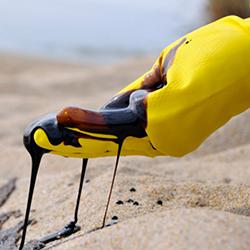Gulf Oil Spill
On April 20, 2010 there was an explosion on the Deepwater Horizon offshore drilling platform in the Gulf of Mexico. Two days after the explosion and fire, the oil drilling rig sank. A huge amount of crude oil leaked from the oil well. The leak was about 5,000 feet below the surface of the Gulf.
The oil well was finally capped in mid-July. By then, almost 5 million barrels of oil had been spilled into the Gulf. The oil spill harmed wildlife along the large coastal areas of Louisiana, Mississippi, Texas, Alabama, and Florida. Fish, turtles, and other animals and plants that live in the Gulf were hurt or killed by the spilled oil. Birds that landed in the water became covered in oil and could not fly. Fishing boats could not collect fish from the oily water. Oil washed up on beaches and into marshes.
It takes many years for the environment to recover from a large oil spill.
What NIEHS Is Doing
- Safety Training – Within days of the explosion, the NIEHS Worker Education & Training Program facilitated safety training for more than 100,000 cleanup workers.
- GuLF STUDY– NIEHS is heading research on the health of the workers and volunteers most directly involved in the oil spill clean-up.
- Gulf Research Consortia – NIEHS provided money to help researchers work with people who live in the Gulf Region to take care of problems caused by the oil spill.




